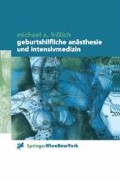Zusammenfassung
Die Betreuung von Schwangeren unter der Geburt gehört zu den Routineaufgaben des Anästhesisten. Gelegentlich müssen operative Eingriffe auch zu einem früheren Zeitpunkt während der Schwangerschaft vorgenommen werden. Einige grundsätzliche Feststellungen zur Perinataltoxikologie und zu den Gesetzmäßigkeiten der Arzneimitteltherapie während der Stillzeit sollen daher in diesem Kapitel zusammengefaßt werden.
Access this chapter
Tax calculation will be finalised at checkout
Purchases are for personal use only
Preview
Unable to display preview. Download preview PDF.
References
Wharton RS et al (1979) Fetal morphology in mice exposed to halothane. Anesthesiology 51: 532–537
Mazze RJ, Wilson AI, Rice SA, Baden JM (1985) Fetal development in mice exposed to isoflurane. Teratology 32: 339–345
Maaze RS et al (1986) Reproductive and teratologic effects of nitrous oxide, halothane, isoflurane, and enflurane in Sprague-Dawley rats. Anesthesiology 64: 339–344
Baden JM, Funjinaga M (1991) Effects of nitrous oxide on day 9 rat embryos grown in culture. Br J Anaesth 66: 500–503
Fujinaga M, Baden JM, Mazze RI (1989) Susceptible period of nitrous oxide teratogenicity in Sprague-Dawley rats. Teratology 40: 439–444
Mazze RI, Fujinaga M, Baden JM (1988) Halothan prevents nitrous oxide teratogenicity in Sprague-Dawley rats; folinic acid does not. Teratolology 38: 121–127
Cohen EN, Belville JW, Brown BW (1971) Anesthesia, pregnancy, and miscarriage: a study of operating room nurses and anesthesists. Anesthesiology 35: 343–347
Spence AA (1987) Environmental pollution by inhalational anaesthetics. Br J Anaesth 59: 96–103
Cote CJ, Kenepp NB, Reed SB, Strobel GE (1976) Trace concentrations of halothane in human breast milk. Br J Anaesth 48: 541–543
Finster M et al (1966) Plasma thiopental concentrations in the newborn following delivery under thiopental-nitrous oxide anesthesia. Am J Obstet Gynecol 95: 621–629
Mc Donald JS, Mateo CV, Reed EC (1972) Modified nitrous oxide or ketamine hydrochloride for cesarean section. Anesth Analg 51: 975–985
Gin T, Gregory MA, Oh TE (1991) The hemodynamic effect of propofol and thiopentone for induction of cesarean section. Anaesth Intensive Care 18:175–179
Gregory MA, Davidson DG (1991) Plasma etomidate levels in mother and fetus. Anaesthesia 46: 716–718
Andersen LW, Quist T, Hertz J, Morgensen F (1987) Concentration of thiopentone in mature breast milk and colostrum following an induction dose. Acta Anaesth Scand 31: 30–32
Dailland Pcockshott ID, Lirzin JD, Jaquinot P, Jorrot JC, Devery J, Harmey JL, Conseiller C (1989) Intravenous propofol during Cesarean Section: placental transfer, concentrations in breast milk, and neonatal effects. A preliminary study. Anesthesiology 71: 827–834
Briggs HA, Freeman RK, Yaffe SJ (1994) Drugs in Pregnancy and Lactation. 4. Aufl. Baltimore, Williams & Wilkins
McElhatton PR, Sullivan FM, Volans GN (1996) Paracetamol overdose in pregnancy: analysis of the outcomes of 300 cases referred to the Teratology Information Service of the National Poison Information Service. Reprod Toxicol 11: 85–94
Slone D, Siskind V, Heinonen OP (1976) Aspirin and congenital malformations. Lancet 1: 1373–1375
Van der Heijden et al (1994) Persistent anuria, neonatal death, and renal microcystic lesions after prenatal exposure to indomethacin. Am J Obstet Gynecol 171: 617–623
Norton ME Merrill J, Cooper AB, Kuller JA, Clyman RI (1993) Neonatal complications after the administration of indomethacin for preterm labor. N Eng J Med 329: 1602–1607
Carlan SJ, OíBrien WE, Jones MH, OíLeary TD, Roth L (1995) Outpatient oral sulindac to prevent recurrence of preterm labor. Obstet Gynecol 85: 769–774
Kramer WB et al (1995) Placental transfer of sulindac and ist active sulfide metabolite in humans. Am J Obstet Gynecol 172: 886–890
Baraka A, Haroun S, Dassili M, Abu-Haider G (1975) Response of the newborn to succinylcholine injection in homozygotic atypical mothers. Anesthesiology 43: 115–116
Abboud TK et al (1981) Use of Glycopyrrolate in the parturient: effect on the maternal and fetal heart and uterine activity. Obstet Gynecol 57: 224–227
Fraser D, Turner JWA (1963) Myasthenia gravis and pregnancy. Proc Royal Soc Med 56: 379–381
Briggs GG, Freman RK, Yaffe SJ (1994) Drugs in Pregnancy and Lactation. 4. Aufl. Baltimore, Williams & Wilkins
World MJ (1993) Odansetron and hyperemesis gravidarum. Lancet 341:185
Saxen I, Saxen L (1975) Association between maternal intake of diazepam and oral clefts. Lancet 2: 298
Rosenberg L, Mitchell AA (1984) Lack of relation of oral clefts to diazepam use in pregnancy. N Eng J Med 310: 11–22
Scanlon JW (1975) Effect of benzodiazepines in neonate. N Eng J Med 292(12): 649–650
Gillberg C (1977) “Floppy infant syndrome” and maternal diazepam [letter]. Lancet 8031: 244
Fung BK, Gislefoss AJ, Ho ES (1992) The sedative effect of intravenous injection of low dose midazolam during spinal anesthesia in cesarean section. Ma Tsui Hsueh Tsa Chi 30: 159–162
Ginsberg JS, Hirsh J (1989) Antikoagulants in pregnancy. Ann Rev Med 40: 79–86
Becker MH, Genieser NB, Feingold M (1975) Chondrodysplasia punctata: is maternal warfarin a factor? Am J Dis Child 129: 356–359
Schardein JL (1993) Chemically Induced Birth Defects. 2. Aufl. New York, Marcel Dekker
Author information
Authors and Affiliations
Rights and permissions
Copyright information
© 2000 Springer-Verlag Wien
About this chapter
Cite this chapter
Frölich, M.A. (2000). Anästhetika und Analgetika in Schwangerschaft und Stillzeit. In: Geburtshilfliche Anästhesie und Intensivmedizin. Springer, Vienna. https://doi.org/10.1007/978-3-7091-6317-7_15
Download citation
DOI: https://doi.org/10.1007/978-3-7091-6317-7_15
Publisher Name: Springer, Vienna
Print ISBN: 978-3-211-83172-4
Online ISBN: 978-3-7091-6317-7
eBook Packages: Springer Book Archive

